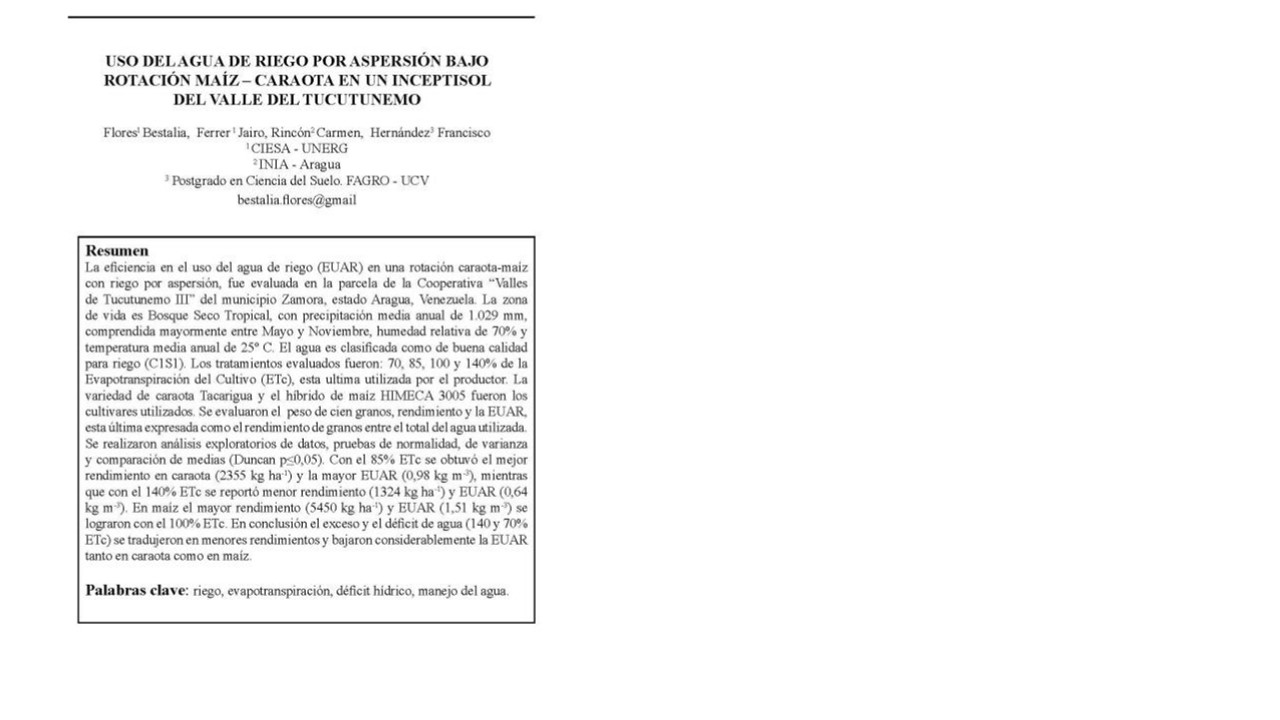Use of irrigation water by low spraying maize rotation - caraota in an inceptisol del Valle del Tucutunemo
Keywords:
Irrigation, evapotranspiration, water deficit, water managementAbstract
The efficiency in the use of irrigation water (EUAR) in a caraota-corn rotation with sprinkler irrigation was evaluated in the plot of the Cooperative "Valles de Tucutunemo III" of Zamora municipality, Aragua state, Venezuela. The life zone is Tropical Dry Forest, with average annual rainfall of 1,029 mm, comprised mostly between May and November, relative humidity of 70% and average annual temperature of 25o C.
Downloads
References
Andrade, F. H.; Sadras, V. O. (2000). Efectos de la sequía sobre el crecimiento y rendimiento de los cultivos.En: Bases para el manejo del maíz, el girasol y la Soja. (Eds) Andrade, F.H. y V.O. Sadras. EEA-INTA Balcarce, Fac. de Ciencias Agrarias UNMP. 173-206.
CEPAL. (1999). Tendencias Actuales de la Gestión del Agua en América Latina y el Caribe. En: Avances en la Implementación de las Recomendaciones contenidas en el Capítulo 18 del Programa 21, LC/L.1180, Santiago de Chile, Chile.
CNA. (2004). Comisión Nacional del Agua. Ley de Aguas Nacionales y su Reglamento. Secretaría del Medio Ambiente y Recursos Naturales. México, D.F. 174 pp.
Doorenbos, J.; Kassam, A.H. (1979). Yield response to water. Estudio de Riego y Drenaje No. 33, Organización de las Naciones Unidades para la Agricultura y la Alimentación, Roma, 193 pp.
El-Noemani, A.; Aboamera, M. A; Aboellil, O.M.; Dewedar, (2009). Growth, yield, quality and water use efficiency of pea (Pisum sativum L.) plants as affected by evapotranspiration(ETo) and sprinkler height. Minufiya J.Agric. Res. 34(4): 1445-1466.
Erdem, T.; Erdem, Y.; Orta, H.; Okursoy, H. (2006). Water-yield relationships of potato under different irrigation methods and regimens. Scientia Agricola. 63(3): 226-231.
FAOSTAT. (2003). Bases de datos de producción mundial y comercio internacional de maíz. FAO, Roma.
GWP. (2001). Global Water Partnership. Los principios de Dublín reflejados en una evaluación comparativa de ordenamientos institucionales y legales para una gestión integrada del agua, [en línea]. Recuperado el día 30 de octubre de 2012, de http://www.cepis.org.pe/ bvsarg/e/fulltext/dublin1/dublin1.pdf
Hsiao, T.; Acevedo, E. (1974). Plant responses to water déficits, water use efficiency and drought resistance. Agricultural Meteorology. 14: 59-84.
Kang, S.; Shi, W.; Zhang, J. (2000). An improved water-use efficiency for maize grown under regulated deficit irrigation. Field Crops Research. 67: 207-214.
Klocke, L. (1996). Evapotranspiration (ET) or Crop Water Use Neb Guide G90- 992-A. Institute of Agriculture and Natural Resourses. University of Nebraska-Lincoln. USA.
Lamm, F.R.; Trooien, T.P. (2001). Irrigation capacity and plant population effects on corn production using SDI. In Proc. Irrigation Assn. Int’l. Irrigation technical Conf. San Antonio. TX: 73-80.
MARN. (2003). Ministerio del Ambiente y de los Recursos Naturales. Informe Julio 2003. Evaluación hidrologica, Valle del Río Tucutunemo, municipio Zamora, Aragua.
Metin, S.; Yazar, A.; Canbolat, M.; Eker, S.; Felike, G. (2005). Effect of drip irrigation management on yield and quality of field grown green beans. Agricultural Water Management. 71: 243-255.
Pandey, R.; Maranville, J.; Admou, A. (2000). Deficit irrigation and nitrogen effect on maize in a Sahelian environment: I. Grain yield and yield components, Agricultural Water Management. 46(1): 1-13.
Payero, J.O; Klocke, L. N.; Schneekloth, J. P., Davison, D.R. (2006). Comparison of irrigation strategies for surface-irrigated corn in West Central Nebraska. Irrigation Science. 24 (4): 257-265.
Rathore, T.; Warsi, M.; Zaidi, P.; Singh, N. (1997). Waterlogging problem for maize production in Asian region. TAMNET News Letter 4: 13-14.
Rivetti, A. (2006). Producción de maíz bajo diferentes regímenes de riego complementario en Río Cuarto, Córdoba, Argentina. I. Rendimiento en grano de maíz y sus componentes. Rev. FCA UNCuyo. Tomo XXXVIII. N° 2. 25-36.
Rojas, R.; Palacios, E.; Ramírez, C.; Exebio, A. (1990). Validation of the prediction model for grain bean yield. Agrociencia. México. 1 (4): 7 -24.
Sánchez, I.; Macas, H.; Heilman, P.; González, G.; Mendoza, S.; Inzunza, M.; Estrada, J. (2006). Planeación Multi objetivo en los distritos de riego de México. Aplicación de un sistema de auxilio para la toma de decisiones. Ingeniería Hidráulica en México. 21 (3): 101 – 111.
Schneekloth, JP.; Klocke, NL; Hergert, GW; Martin, DL; Clark, RT. (1991). Crop rotations with full and limited irrigation and dryland management. Transactions of the ASAE USA. 34 (6): 2372-2380.
Tolk, J.; Howell, T.; Evett, S. (1998). Evapotranspiration and yield of corn grown on three high Plains soils. Agronomy Journal. 90:447-454.
Warnock, R.; Valenzuela, J.; Trujillo, A.; Madriz, P.; Gutiérrez, M. (2006). Área foliar, componentes del área foliar y rendimiento de seis genotipos de caraota. Agronomía Tropical. 56(1): 21-42.
Zaidi, P.; Singh, N. (2002). Identification of morpho-physiological traits for excess soil moisture tolerance in maize. In Stress and Environmental Physiology (K. K. Bora, K. Singh, and A. Kumar, Eds.). 172–183.

Downloads
Published
How to Cite
Issue
Section
License

This work is licensed under a Creative Commons Attribution-NoDerivatives 4.0 International License.







